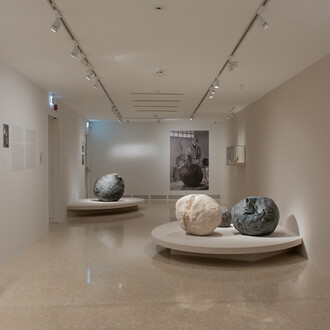From 25 April to 23 August, on the occasion of the yearly reopening of Palazzo Cini, San Vio, Venice, the extraordinary gallery that conserves masterpieces of Renaissance art from Tuscany and Ferrara that belonged to the collector Vittorio Cini, Ettore Spalletti will be creating an ad hoc exhibition project in the second floor of the Palazzo. This will inaugurate this recently restored space which is destined for temporary exhibitions. Spalletti will be presenting his personal interpretation of the domestically-scaled rooms by observing the variations of light and creating an itinerary that will show well-known works together with others that have never been seen before; their positioning in the "Cini home" is a tribute to the taste of this Venetian collector.
Ettore Spalletti (1940), an artist who represented Italy at the 1997 Venice Biennale, has recently been the subject of large anthological exhibitions, and his works are to be found in the most prestigious Italian and foreign museums. He has elaborated a project for the rooms of the building which creates a continuous link with the past, the time when this space was experienced every day by the great collector Vittorio Cini.
Already in his visits to the gallery's permanent collection, and during his survey of the building's first floor - while it was still being restored - the artist found inspiration for the selection of works to be placed in the domestic areas of this palazzo on the Grand Canal. In fact the rooms will host a show which expresses a deep relationship with a space that was, and for the artist still remains, domestic; at the same time, the antique masterpieces exhibited in the gallery - including, among others, paintings by Pontormo, Botticelli, Giotto, and Cosmè Tura - will be an important presence for the artist.
The variety, complexity, and profundity of this master of contemporary Italian art will lead the visitors through an all-inclusive visual experience of familiar works and others never previously shown, and now placed respectfully in the "Cini home" as a refined tribute to the great collector Vittorio Cini.
Ettore Spalletti is an artist who inquires into the relationship between nature and abstraction, a relationship in which the experience of landscape is central, one that combines classical memories with modernity, and which he filters through his refined aesthetic sensibility. He is a painter who makes monochrome a metaphor for his perceptive sensibility, but he experiences the relationship between painting and sculpture as the articulation of colour and volumes in space. He makes use of such materials as alabaster, marble, onyx, gold leaf, metal, precious stones, paper, and pure pigment. This is how he himself described his work in the catalogue of the 2014 retrospective show organized by the Madre museum, Naples; MAXXI, Rome; and GAM, Turin: "My relationship with art means to go into the studio every day, walk around it, and look around. To suddenly become aware of the approach of a colour, to try to stop it, to feel form, think of the lines of geometry: horizontal, vertical, oblique, curved... then break geometry itself to fill it with a material that, like smoke, dissolves into fine dust. In the studio I shift a work in order to find a shadow and, perhaps, in the sensation of that shadow to find a new colour. The colours come about like this, one after another. The most characteristic colours of my work are light blue and pink. Light blue is an atmospheric colour in which we are continuously immersed: it is the colour of the sky. I use pink as the colour of flesh which is never fixed but changes in harmony with our moods: when joyful it becomes pale or livid. Grey for me, instead, is welcoming and it accompanies other colours beautifully."
From halfway through the 1970s, Ettore Spalletti (Cappelle sul Tavo, 1940) has created a language on the cusp between painting and sculpture, attentive to light and space, and it mirrors both modern abstraction and Renaissance painting. Solo shows have been devoted to his work by such prestigious institutions as the Museum Folkwan, Essen (1982); the Museum Van Hedendaagse Kunst, Ghent (1983); the Halle d’art contemporain, Rennes (1988); De Appel, Amsterdam; the Kunstverein, Munich (1989); Portikus, Frankfurt (1989); the Musée d’Art Moderne de la Ville de Paris (1991); IVAM, Valencia (1992); the Solomon R. Guggenheim Museum, New York (1993); the Museum van Hedendaagse Kunst, Antwerp (1995); the Musée d’Art Moderne et Contemporain, Strasburg (1998); the Museo di Capodimonte, Naples (1999); the Fundaciòn La Caixa, Madrid (2000); the Henry Moore Institute, Leeds (2005); the French Academy - Villa Medici, Rome (2006); the Museum Kurhaus, Cleves (2009); the Galleria Nazionale d’Arte Moderna, Rome (2010); MAXXI, Roma; the Museo MADRE, Naples; GAM, Turin (2014). He has participated in various international exhibitions, among which editions VII and IX of Documenta, Kassel, in 1982 and 1992, and the Venice Biennales of 1982, 1993, 1995, and 1997.











